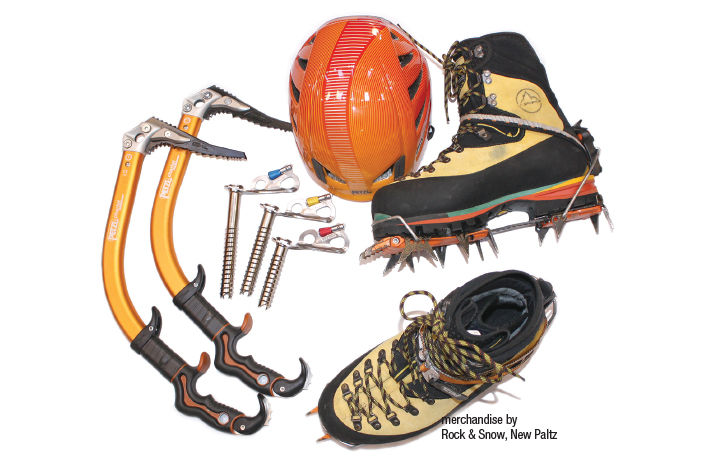
text & photos by Joe Vitti
Like pirates' treasure, ice climbs in the Catskills were once the subject of myth and lore.
Today these frozen gems have become some of the most popular climbs in the Northeast, with hundreds of climbers visiting the area each season. With consistent cold, steep-sided ravines and craggy hillsides, the Catskills offer a fantastic array of climbs of all difficulties. There are low-angled climbs ideal for beginners, as well as towering pillars climbable by only the most fit and expert.
Despite it’s edgy reputation, ice climbing has become one the fastest growing adventure sports. The equipment that climbers use has been relentlessly refined, and today allows even relative beginners to ascend routes once considered the realm of only the most dedicated uber-athletes.

It is a gear intensive sport:
specialized boots, crampons, ice axes, and ice screws are just some of the equipment needed for the sport.

Ice axes have sharp picks masterfully designed to stick into ice without cracking or displacing too much of it. The shafts of the axes are curved to prevent the climber from smashing their knuckles when swinging the axe hard at the ice.
Ice screws are crafted to aggressively bite into the ice surface and allow for the creation of surprisingly strong anchors.
Boots for ice climbing strike a balance between being light and still warm enough for cold and snowy days. They need to be waterproof and specially constructed to have crampons attached to them.
Crampons are a system of steel spikes that are strapped to the boots and allow climbers to walk across frozen ground and kick dagger-like "front points" into steep ice.
While ice climbing is less technically difficult than climbing rock, it is vigorous and requires the climber to be aggressive, swinging axes and kicking front points into the surface of the ice. It’s an incredible workout. Some climbers train hard indoors specifically for ice season, while others work themselves into shape by just getting out once the weather turns cold. For beginners, having some decent fitness is all that it really takes to get out there for a first taste.

Frozen waterfalls provide some of nature’s most ephemeral beauty, and herein lies the real pull of ice climbing. It is more than mere sport; places like the Platte Clove, Kaaterskill Clove, and Deep Notch become dramatic sculpture gardens of icy towers in the heart of winter. Bubbling creeks and cascades are waylaid by cold and sculpted by wind and sun into a medium for contemplation and adventure. Once again, our Hudson Valley region is full of surprises!
�Joe Vitti is a full-time rock and ice climbing guide with Alpine Endeavors. He lives with his family in High Falls and leads trips here in the Hudson Valley, as well as climbing areas throughout the United States. Visit Alpine Endeavors here.

